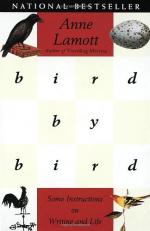|
This section contains 701 words (approx. 2 pages at 400 words per page) |

|
Bird by Bird Summary & Study Guide Description
Bird by Bird Summary & Study Guide includes comprehensive information and analysis to help you understand the book. This study guide contains the following sections:
This detailed literature summary also contains Topics for Discussion and a Free Quiz on Bird by Bird by Anne Lamott.
This non-fiction book, published in 1994, is like a written course on writing and life in which Anne Lamott provides intimate details of her life. These life experiences form the basis for her approach to writing. Her life also provides the material from which she writes. Bird by Bird is a collection of very personal and sometimes tragic life experiences intertwined with various writing methods.
The narrative of Anne's life begins with her father who was also an author. He and his family often socialized with creative and artistic writers, and such social interactions are vivid in Anne's memory. They shape her initial experiences with the written word and the lifestyle of those who write.
A love of books and a deep connection to the experiences presented in the written word provide an escape for Anne as she navigates her childhood and adolescent years. Anne is a nervous child and young woman, often feeling as though she is on the outside looking in on the life of her friends. She is neither conventionally attractive nor unconventionally too smart for the average school social experience. Anne develops her sense of humor as a way of protecting herself and gaining some semblance of participation with her peers.
While the life of an artist often is a challenge for Anne, it is exactly to this kind of life she gravitates. She decides, with the publication and sharing of her first poem in elementary school, that writing is what she wants to pursue in her life. Anne begins this pursuit by working on a single short story. Her father shares this story with his agent, and the agent gives encouraging feedback to continue working on the piece. In the meantime, Anne works a series of odd jobs while toiling away at the story.
Anne's father is diagnosed with and suffering from cancer. It is the midst of this family tragedy that Anne finds the first story she can complete and submit for publication. The story is about her joys and tragedies and those of her family whilst dealing with the illness and death of their patriarch. The same agent who encouraged Anne to keep writing the miserable short story earlier in her career helps Anne to become published for the first time.
Anne discovers that writing is about telling the truth based on her own experiences. As her life progresses, she gives birth to a child who is the next to significantly impact her writing approach. Anne begins to compare writing to raising her son Sam. Sometimes both can be very difficult with little reward, and sometimes writing and child rearing are incredibly rewarding in the little and big moments.
Anne and her son Sam become close friends with Pam. A journal is kept by Anne on the experiences they have together. This journal forms the basis for Anne's next published work. Unfortunately, much like Anne's experience with her father, tragedy is also a part of this novel. Pam is diagnosed with terminal cancer and the journal becomes a tribute to her life and Anne's friendship.
Anne intertwines the aforementioned moments with others taken directly from her writing life, classes and workshops. Her students' inquiry into the writing process and payoff are a constant source of inspiration and information for the reader. The students begin the class, and sometimes end it, with the sole ambition of publication. Anne attempts to help students and the reader of this book understand that writing is a reward in and of itself. The students' exploration of writing is similar to Anne's and she is generous in relating the challenges and victories of writing.
Each chapter is a lesson in writing. Each lesson is illustrated with a personal experience and poignant reminder to tell the truth in writing. The truth is about life, life is about the experiences one has and the story is the experiences told as honestly as possible.
The book ends with Anne's final advice on life and writing. Writing becomes a noble endeavor to positively enhance the life of both author and reader. It is a cathartic exercise from past pains. Writing captures the wonder of life and shares it on the page.
Read more from the Study Guide
|
This section contains 701 words (approx. 2 pages at 400 words per page) |

|



